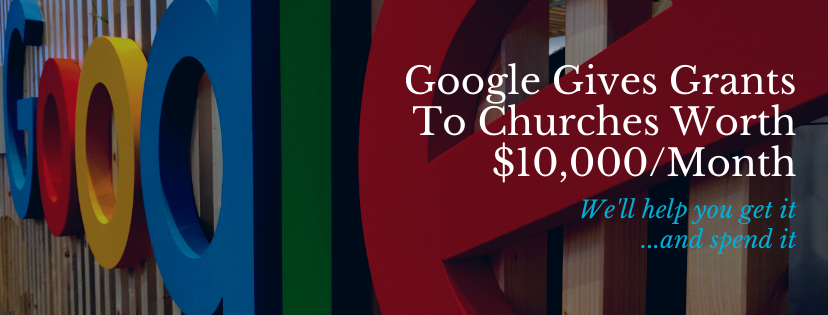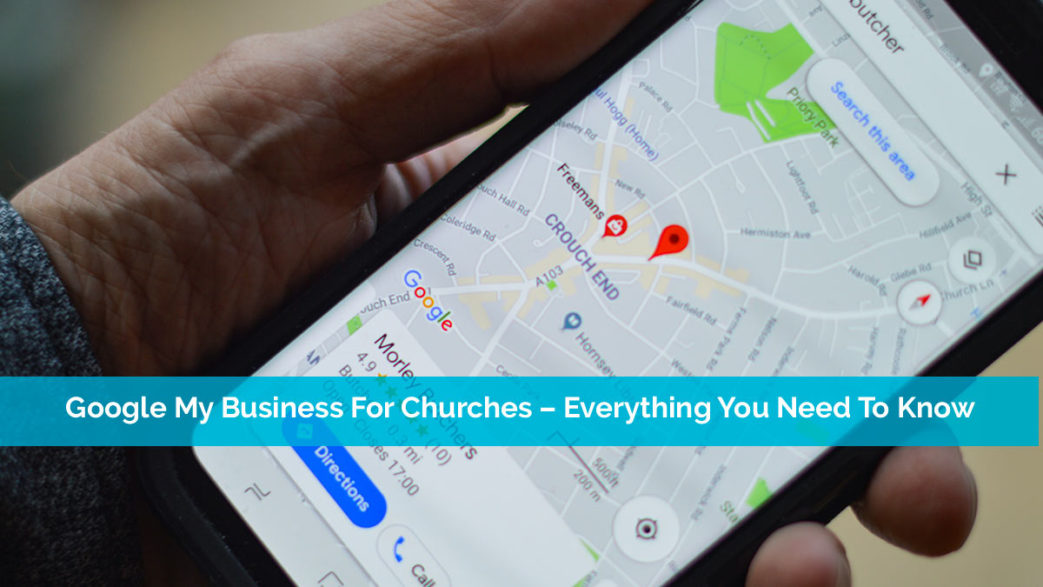Google My Business is one of the most important marketing tools for churches. Not only is it free, but it helps boost your search rank.
The best part is it’s easy to use and aids in your other digital marketing efforts, such as your church website and social media.
Whether your church is brand new or you’ve been around for generations, it’s time to claim your listing and starting putting this valuable tool to work for your church.

What Is Google My Business
Google My Business is an online business directory. However, it’s more than just the Yellow Pages. Since it’s a Google creation, it’s also part of other Google tools, like search. While it’s a good idea to claim or create a listing on several major directories, Google’s is by far the most beneficial.
When you create a listing with Google, it integrates with Google Search and Google Maps. It’s also a critical part of optimizing your local SEO. Verified listings show up more often when someone looks for churches in your area.
If you’ve ever searched for a business on Google before, you’ve likely seen Google My Business listings. These typically show up as some of the first search results. When you click them, you see relevant details, such as the location and hours. You also see reviews and images, if available.
The more detailed your listing, the more likely someone is to either visit in person or check out your church’s website and/or social media pages.
Local Searches Are Your Church’s Best Friend
We’ve already covered how important SEO is for churches. As a local business, local SEO is even more important. That’s why local searches are your church’s best friend.
In most cases, people don’t just search for “church” or “churches.” Instead, they add a local modifier, such as “churches in Atlanta” or “churches near me.” The latter will include whatever city or zip code is currently connected with their Google account.
Only churches that have optimized for local search are going to show up on that coveted first page. Those who are full optimized may even show up above the standard search results.
Even if you don’t have a church website yet, you can still rank high for local searches just by having a Google My Business listing. Think of this as a secondary website. It’s not as fancy and you can’t get as much organic search traffic as you would with a traditional site and a blog, but it’s still highly effective for more targeted local searches.
As an important side note, you should also optimize your church website for local searches. Add your address, a map and mention your area naturally throughout your site. You can even blog about community events, which helps your rank even more. Combining a website and your listing is the ultimate SEO optimization technique.

Relationship With Google Maps
Typically, your church already shows up on Google Maps. If you’re new, this won’t happen immediately. However, adding your address to your Google My Business listing makes sure Google Maps knows where you’re at.
When users perform a local search, maps are shown if Google is certain that the location does exist. The best way to do this is to verify your address on your listing.
You might notice that we keep saying “claim” over “create.” This is because you may already have an automatic listing created. Many businesses are listed in the directory already to help users find more information. However, you won’t get the same SEO benefits if you don’t claim the listing and verify it. All of this is completely free.
Once your account is verified, Google will also show a map of your location. This quickly shows people how to find your church. The easier it is for them to find you, the more likely they are to attend in person. Or, at the very least, they’ll see how close you are and want to know more about your church.
How Google Categorizes Local Searches
Google currently divides local searches into three different categories. Google My Business helps with all three.
The first is the direct search. You don’t really have much competition here, especially if you have a list and/or church website. This is when a user searches for your church by name and/or address. For instance, they might search for Hope Baptist Church Florida or even be more specific by adding a city.
The second is a brand search. Instead of mentioning your church by name, they might search for your ministry program or a special community charity your church created. If you have these listed in your Google My Business listing, it’s easier for Google to associate your church with these branded search terms.
The final is a discovery search. This is when someone is looking for a church and trying to discover you. They don’t know the name, a brand or exact location. This is where many of your visitors will come from. For example, a new family might have moved to Dallas, TX. They might search for “protestant churches in Dallas, TX.”
Having your listing show that you’re a Protestant church in Dallas means you’ll show up much higher in the search results.
Direct Search Results In Knowledge Panel
Another Google product you benefit from is the Knowledge Panel. This is a panel that shows up on the right side of the search results when a user searches for something more specific, such as the name of your church.
As you might have guessed, Google gets information for businesses and non-profits from their Google My Business listing. You can also claim your knowledge panel and ensure all the data is kept up to date. Google provides more details on the differences between knowledge panels and business listings and also explains how to claim your church’s knowledge panel.
Claiming Your Google My Business Profile
Now for the fun part – you get to claim your Google My Business profile. While Google provides the exact details on claiming or adding your church via Google My Business and Google Maps (this is a good idea if your church isn’t showing up in Google Maps yet), we’ll cover the basics just to get you started.
If your church already shows up in Google Maps, go to Google My Business to get started. You can technically use any email address you want, but if you have a church domain email, such as churchstaff@hopevalleychurch.com, use that instead. This keeps your church domain connected to related services, such as your business listings and social media accounts.

If you don’t have a physical location, that’s okay. You can still claim a listing. Some churches bounce from one location to another each week. Just keep your listing updated with your next location by creating an event (more on that shortly).
Once you’ve signed up, search for your church. There is a good chance a listing already exists, but it may not be complete or accurate. Claim the listing if it’s yours. It’s better to claim and fix a listing than create a duplicate. That just creates competition and may make your church look like spam.
If one doesn’t exist, follow the prompts to create a new listing. Either method you use still requires you to verify the listing. Don’t worry, this isn’t difficult, but may take up to a week or more depending on the method used.
Google typically asks to verify a listing by snail mail (you’ll get a card in the mail with a verification code to enter), phone call or email. Once you enter the code, the listing is all yours and verified. It’s important to verify or you might not show up in local searches.
Once verified, it’s time to start optimizing your listing.
Fill Out All Relevant Information
Make sure you fill out all the relevant information. Every thing might not apply to your church. For example, a church that doesn’t have the same physical location each week won’t be able to enter an address, but can enter a city and/or state.
Also, many churches opt to skip the service area detail. This allows you to show up in listings outside of your general area. For instance, if your service area is a 25 mile radius, but some searches for “churches near me” and they live 35 miles from your church, you might not show up.
Carefully go through each option to provide as much detail as possible. The idea is give searchers everything they need to know to make the choice to either visit or check out your digital presence to learn more, such as a website or social media.
Be Specific For Best Results
Try to be as specific as possible when completing your listing. One very important area is the category for your business. Yes, “church” is an option, but someone might not be looking for just a church. They might look for a specific denomination or even non-denominational.
Make sure you’re choosing details that are specific to your church and not general. This helps you show up in more relevant local searches. Remember, the more optimized, the more useful it is to your church.
Add Events To Your Profile
Your Google My Business listing isn’t static. You’re able to change things and keep it current. This includes adding events. Have an upcoming concert? Add it.
This is perfect for churches that move around too. List your next several locations as events so people know where to find you. This also helps with local search as Google sees those locations listed and associated your listing with them.
For people finding your church for the first time through Google, having a list of events also shows how active your church is and whether they’re interested in what you do outside of services. You can provide links to give people more information or just refer them to your website’s events page.
Stay On Top Of Reviews
An added benefit of claiming your listing is you can stay on top of any reviews. Respond to reviews and interact with your members and visitors.
However, remember that you won’t always be able to please everyone. If you do get a negative review, simply message them to find out more. Never ask them to change their review. If they do change it, that’s great. However, you can get penalized if you try to get someone to change their review.
Seeing you interacting with reviews shows people that you care. Learn from negative reviews (if they’re valid) and be grateful for positive reviews.

Optimize With A Virtual Tour
In addition to adding pictures to your listing (which you definitely should), a virtual tour is a great way to optimize your listing. While a picture is great, you can take visitors to your profile on a tour of the inside and outside of your church.
This is ideal for new visitors who might appreciate knowing exactly where to go and what to expect when they arrive at your church for the first time. You’ll have to create the video yourself or hire someone to do it. However, it’s a great bonus to your listing, but not required.
Using Google My Business Insights
Wouldn’t it be great to learn more about how people are finding your church online? If you have a church website, you might already have taken a look at your site data or even used Google Analytics.
Google My Business has a similar feature called Insights. Quickly discover what people are searching for that leads them to your listing. You’ll see what keyword phrases you’re optimized for and see if there are others you might want to use as well.
Let Your Members Know
Finally, let your members know about your listing. Ask them if they could review it to see if everything looks good. Also, ask them to consider leaving a review, if they want to. Having a few positive reviews on your listing is always a good thing.
Want to help visitors to your listing find out even more? See how our church website services give you the perfect platform for engaging with online visitors and your members even more.





Comments 6
Trying to learn all of this. Thanks for the info hopefully it will help us rank better.
Thanks for the info. Still trying to find ways to move up our position. I think I will add more to events and do a virtual tour as well.
Sounds like a great idea!
Author
It is tedious, but getting listed on lots of local directories is a tried and true way to boost results.
Thank you !!
Author
You got it, Anthony! Glad this was helpful.